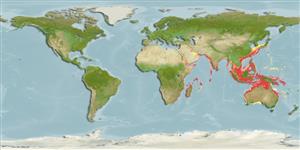>
Carangiformes (Jacks) >
Carangidae (Jacks and pompanos) > Naucratinae
Etymology: Seriolina: Latin word diminutive with the meaning of a large earthenware pot (Ref. 45335).
More on author: Rüppell.
Environment: milieu / climate zone / depth range / distribution range
ນິເວດວິທະຍາ
ສັດທະເລ; ນ້ຳກ່ອຍ ກ່ຽວກັນຫີນ; ລະດັບຄວາມເລິກ 20 - 150 m (Ref. 30573). Tropical; 38°N - 35°S, 20°E - 163°E
Indo-West Pacific: Red Sea and East Africa to Japan, Australia and Solomon Island. Southeast Atlantic: southeast coast of South Africa (Ref. 3197).
ຂະໜາດ / ນ້ຳໜັກ / Age
Maturity: Lm ? range ? - ? cm
Max length : 77.5 cm TL ຕົວຜູ້/ບໍ່ມີເພດ; (Ref. 30504); common length : 50.0 cm TL ຕົວຜູ້/ບໍ່ມີເພດ; (Ref. 5450); ນ້ຳໜັກສູງສຸດທີ່ເຄຍຈັດພີມມາ: 5.2 kg (Ref. 3287)
ຄີ (ໜາມ)ແຂງຢູ່ຫຼັງປາ (ທັງໝົດ) : 8 - 9; ຄີຫຼັງຂອງປາ (ຄີອ່ອນ) (ທັງໝົດ) : 30 - 37; ຄີ(ໜາມ) ແຂງຢູ່ຄີກົ້ນປາ
ກຸ່ມປາກະດູກແຂງ
ຄວາມຖີ່ຂອງກຸ່ມຖ່າຍທອດພັນ
ປາທີ່ມີການເຄື່ອນຍ້າຍຈາກທະເລໄປຫານ້ຳຈືດ ແລະນ້ຳຈືດຫາທະເລ
ປາທີ່ມີການເຄື່ອນຍ້າຍຈາກທະເລແລະໄປໄຂ່ຢູ່ນ້ຳຈືດ
ຄີກົ້ນຂອງປາ
ສັດທີ່ມີກະດູກສັນຫັຼງ
ການຖ່າຍທອດທາງກຳມະພັນຈາກພໍ່ແມ່ຫາລູກ: 2; ຄີກົ້ນຂອງປາ: 15 - 18. Color bluish grey to black dorsally, white to dusky below; 5-7 dark oblique bands or blotches on young disappear with age. Posterior spines of dorsal fin minute or embedded in large adults; first anal spine usually embedded. Gill rakers are mostly rudiments. Grooves of caudal peduncle present dorsally and ventrally. Maxilla reaching below rear margin of the eyes.
Mainly in offshore reefs on the continental shelf (Ref. 30573, 48635), on rocky bottoms (Ref. 11230). Non-schooling. Juveniles under weed rafts and adults are sometimes seen with the large planktivores such as whale sharks (Ref. 48635). Adults feed on demersal fishes, cephalopods, and shrimp (Ref. 11441). Excellent food fish (Ref. 3197); marketed fresh and dried salted (Ref. 3287).
Life cycle and mating behavior
ການຈະເລີນເຕັມໄວ | ການສືບພັນ | ການວາງໄຂ່ | ໄຂ່ | ຄວາມດົກຂອງໄຂ່ປາ | ຕົວອ່ອນ
Paxton, J.R., D.F. Hoese, G.R. Allen and J.E. Hanley, 1989. Pisces. Petromyzontidae to Carangidae. Zoological Catalogue of Australia, Vol. 7. Australian Government Publishing Service, Canberra, 665 p. (Ref. 7300)
IUCN Red List Status (Ref. 130435: Version 2024-2)
Threat to humans
Harmless
Human uses
ການປະມົງ: ທີ່ເປັນການຄ້າໜ້ອຍ; ຊະນິດປາທີ່ຖືກນຳໃຊ້ເຂົ້າໃນການຫາເພື່ອເປັນເກມກິລາ: ແມ່ນ
ເຄື່ອງມື
Special reports
Download XML
ແຫຼ່ງອີນເຕີເນັດ
Estimates based on models
Preferred temperature (Ref.
123201): 21.9 - 28.3, mean 27 °C (based on 911 cells).
Phylogenetic diversity index (Ref.
82804): PD
50 = 1.0000 [Uniqueness, from 0.5 = low to 2.0 = high].
Bayesian length-weight: a=0.02344 (0.01170 - 0.04697), b=2.93 (2.75 - 3.11), in cm total length, based on LWR estimates for this species & (Sub)family-body (Ref.
93245).
ຊັ້ນເຂດຮ້ອນ (Ref.
69278): 4.2 ±0.57 se; based on food items.
ຄວາມຢືດຢຸ່ນ (Ref.
120179): ຂະໜາດກາງ, ປະຊາກອນຕຳ່ສຸດທີ່ໃຊ້ເວລາສອງເທົ່າ 1.4 - 4.4 ປີ (Assuming tm=2-4).
Fishing Vulnerability (Ref.
59153): Moderate to high vulnerability (51 of 100).
Climate Vulnerability (Ref.
125649): High vulnerability (61 of 100).
Nutrients (Ref.
124155): Calcium = 38.8 [16.6, 67.1] mg/100g; Iron = 0.608 [0.325, 1.237] mg/100g; Protein = 19 [17, 21] %; Omega3 = 0.136 [0.080, 0.257] g/100g; Selenium = 45.2 [22.4, 89.8] μg/100g; VitaminA = 33 [8, 136] μg/100g; Zinc = 0.815 [0.528, 1.203] mg/100g (wet weight); based on
nutrient studies.
